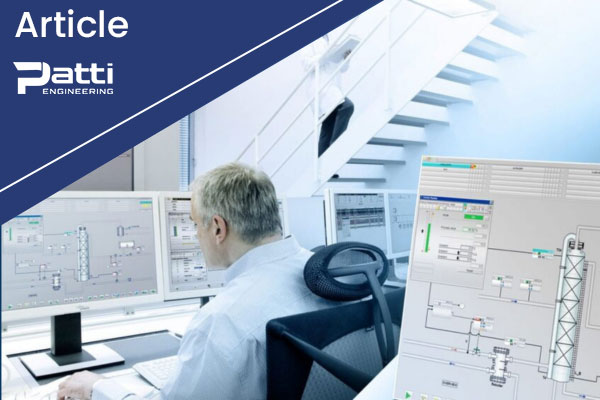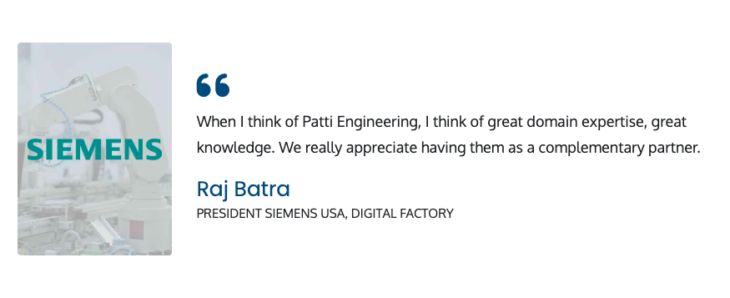
DCS vs. PLC: Siemens SIMATIC PCS 7
Programmable Logic Controller (PLC) and Distributed Control Systems (DCS)
With the advancement of microprocessors and automation technology, the lines have blurred between the Programmable Logic Controller (PLC) and Distributed Control Systems (DCS). It is more challenging than ever for process manufacturers to select the best technology for their application.
Discrete Automation and the PLC
With most discrete automation applications, the PLC is the heart of the system. It contains the logic to move the products through the machining or assembly line. The PLC can handle high-speed applications that require scan rates of 10 milliseconds or less, including operations involving motion control, high-speed interlocking, or control of motors and drives. Fast scan rates are necessary to be able to effectively control these devices. The Human Machine Interface (HMI) provides the operator with supplemental information or exception data.
Process Automation and the DCS
In process automation where the environment can be volatile and dangerous and where operators can’t see the actual product, the HMI is considered the heart of the system. It provides a window into the process and operators play a more active role utilizing the HMI to monitor and control the process. The DCS is not designed to handle high-speed applications like the PLC can. The regulatory control loops normally scan in the 100 to 500 millisecond range. To have the control logic execute faster could cause excessive wear on final control elements such as valves, resulting in premature maintenance and process issues.
What are the key PLC vs. DCS differentiators?
Programming and Logic
PLC’s high level programming languages allow for creating custom logic. The PLC comes with an extensive variety of functions and elemental building blocks that can be custom developed and chained together. Creation of the custom code from scratch allows for integration of functions and products into a seamless architecture.
Flexibility
A traditional DCS does not have PLC like flexibility. The traditional DCS has pre-engineered solutions consisting of standards, templates, and extensive libraries “out-of-the-box”. A DCS trades unlimited functionality and customization for repeatability and dependability. The system is expected to function as a complete solution with standard functions.
The PLC has flexibility and open architecture whereas the DCS has an intuitive programming platform, which utilizes predefined and pretested functions to save time and drive repeatability. The PLC’s ladder logic is best for discrete control applications. The DCS’s function block diagram is preferred for continuous control and implementing alarming schemes.
Combining the strengths of both the PLC and DCS with Siemens SIMATIC PCS 7
If your application would be best served using both PLC and DCS you may need a process control system for hybrid applications. In the old days if you chose to go with a DCS you were locked into that company and the flexibility of integration of the PLC open architecture world was not an option. Not true today, as we look at the Siemens SIMATIC PCS 7.
Siemens SIMATIC PCS 7 is more than a DCS, it is a process control system that gives you both PLC and DCS functionality.
Open Architecture
The open architecture of SIMATIC PCS 7 process control system enables full integration of all the automation systems in your plant: process, batch, discrete and safety, and all the field devices; instrumentation, analytics, motors, drives, and safety into a single platform, with common tools for engineering, visualization, and facility-wide asset and maintenance management.
Software Extensions
The PCS7 platform is essentially software extensions for the Siemens S7-400 PLC and Siemens HMI running WinCC. These software extensions come in the form of function libraries and software tools that are used to create a high-level software solution that when compiled runs on the same hardware platform as a traditional PLC. The controller software and HMI software are closely integrated and much of the HMI functionality is automatically generated based on the content of the controller program.
Development
From a development standpoint, there is an extensive and comprehensive software library that is used to develop the overall software solution. Very little, if any, lower-level programming is required. Development time is reduced because of the software library and the fact that much of the HMI functionality is automatically generated. From a safety standpoint, hardware and software redundancy is fully supported by PCS7.
Time and Cost Savings
The standardization of much of the control logic may reduce the time/cost of a new engineer picking up an existing project and understanding it. There could be significant cost savings from systems with heavy redundancy or duplicate hardware and process.
Updates to Siemens SIMATIC PCS 7
Overview
While Siemens SIMATIC PCS 7 distributed control system has been a proven workhorse trusted by process industries for decades, Siemens has continuously updated the robust system architecture including creating an additional building block in route for the Digital Enterprise. The latest version of SIMATIC PCS 7 is Version 9.1.
SIMATIC PCS version 9.1
SIMATIC PCS 7 Version 9.1 now provides users with an updated master data library, called the Advanced Process Libraries (APLs), which includes a variety of standardized and system-tested Control Module Types (CMT) and Equipment Module Types (EMT). As opposed to the first block templates, these new modules can increase the potential and flexibility of the single CMTs. While some of the APLs are specifically built for larger customers, most of them are general APLs for general application, which include functions, function blocks, data types, and data blocks for various continuous and sequential function charts (SFC).
Support and Security
With the end of support for some operating systems, plant owners and operators face increased security risks. SIMATIC PCS 7 Version 9.1 tackles this challenge by supporting Windows Server 2019 Standard Edition and Windows 10 Enterprise 2019 LTSC, ensuring compatibility with current workstation Industrial PCs (IPCs). This will make sure that the installation of the latest Microsoft updates are more simple and convenient. Additionally, SIMATIC PCS 7 V9.1 is now friendly with Windows Defender Antivirus, better protecting the system from attacks.
Which Industries can benefit from PCS7?
PCS7 was developed specifically for process control applications. The PCS7 is not used in place of a PLC, but it is a tool or programming method for using a PLC. A PLC is still used in conjunction with the process control system, but PCS7 is used to build the control software and interrelations. PCS7 is more likely to replace a system HMI than the PLC. PCS7 uses WinCC to provide a SCADA solution for supervisory control and the acquisition of data for a process environment. In general, the types of projects you would use PCS7 would be Chemical, Energy, Utilities, Food and Beverage, and Pharmaceutical.
Finding a Solution
As a Siemens Solution Partner, Patti Engineering has the expertise to help you evaluate the automation technologies available to help you determine the best solution for your business to operate at peak efficiency. The right solution can make all the difference to your return on investment and bottom-line profits.

Editor’s Note: This newsletter was originally published in November 2011 and has been updated for comprehensiveness and clarity.
Related categories: Blog Control Systems Integration


